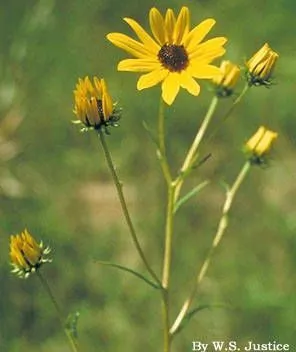
Author: L.
Bibliography: Sp. Pl.: 906 (1753)
Year: 1753
Status: accepted
Rank: species
Genus: Helianthus
Vegetable: False
Observations: NC. & E. U.S.A.
The Swamp Sunflower, also scientifically known as Helianthus angustifolius, is a vibrant and stunning member of the Asteraceae family. First described in the landmark work “Species Plantarum” in 1753 by the renowned botanist Carl Linnaeus, this delightful plant has captivated botanists and garden enthusiasts alike for centuries.
Primarily found in the southeastern regions of the United States, the Swamp Sunflower thrives in its native habitats of North Carolina and the east coast areas. It is particularly adapted to wetlands, marshes, and other moist, swampy environments, which is how it earned its common name. This versatility in habitat highlights the plant’s resilience and its ability to contribute significantly to the biodiversity of wetland regions.
Characterized by its tall, slender stems and narrow leaves, the Swamp Sunflower can reach impressive heights, often standing between 3 to 10 feet tall. The plant’s most striking feature is undoubtedly its bright yellow flowers, which can appear in late summer to early fall. These blooms, reminiscent of the sun, form a brilliant display that attracts a variety of pollinators, including bees and butterflies, thus playing an essential role in the local ecosystem.
The Swamp Sunflower is also noted for its relatively easy care in suitable environments. It thrives in full sun and, as its native habitat suggests, prefers consistently moist soil but can tolerate occasional dry spells once established. This makes it an excellent choice for rain gardens, naturalized areas, and pollinator gardens, where it can grow with minimal intervention.
Apart from its visual appeal and ecological benefits, Helianthus angustifolius holds cultural significance for various indigenous communities. The sunflower has been used traditionally for its medicinal properties and as a source of nourishment.
In summary, the Swamp Sunflower is more than just a beautiful plant; it is a resilient, ecologically valuable species that adds vibrant color and life to wetland habitats. Its enduring popularity and ease of care ensure that it will continue to be a celebrated part of the American landscape for generations to come.
Hun: kekenylevelű napraforgó
Eng: narrow-leaf sunflower, swamp sunflower
Swe: sumpsolros
En: Swamp sunflower, Narrow-leaf sunflower, Narrow-leaved Sunflower, SWAMP SNEEZEWEED
Ar: دوار الشمس ضيق الأوراق
Hu: Kekenylevelű napraforgó
Sv: Sumpsolros
Taken Oct 6, 2022 by Alex Arriaza (cc-by-sa)
Taken Sep 27, 2022 by Rachael Kirby (cc-by-sa)
Taken Nov 15, 2022 by Mr. G Roberts (cc-by-sa)
Taken Oct 29, 2022 by Rebecca Ryan (cc-by-sa)
Taken Oct 12, 2020 by Jackie Blue (cc-by-sa)
Taken Sep 1, 2022 by gisela ferrer (cc-by-sa)
Taken Oct 7, 2020 by Brad Kelley (cc-by-sa)
Taken Sep 18, 2018 by Anja Collette (cc-by-sa)
Taken Oct 21, 2022 by Connie Veal (cc-by-sa)
Taken Oct 6, 2022 by Alex Arriaza (cc-by-sa)
Taken Oct 22, 2012 by EOL − Richard Spellenberg (cc-by-nc-sa)
Taken Nov 5, 2014 by EOL − Sam Kieschnick (cc-by-nc)
Taken Nov 21, 2013 by EOL − Jason Singhurst (cc-by-nc)
Taken Oct 23, 2015 by EOL − Ken Bosso (cc-by-nc)
Taken Jan 1, 1900 by EOL − Smithsonian Institution, National Museum of Natural History, Department of Botany (cc-by-nc-sa)
Taken Dec 12, 2005 by EOL − Steven J. Baskauf (cc-by-nc-sa)
Taken Dec 12, 2005 by EOL − Steven J. Baskauf (cc-by-nc-sa)
Taken Dec 12, 2005 by EOL − Steven J. Baskauf (cc-by-nc-sa)
© copyright of the Board of Trustees of the Royal Botanic Gardens, Kew.
Growth form>: Rhizomatous
Growth habit>: Forb/herb
Growth rate>: Moderate
Ph maximum: 7.0
Ph minimum: 4.0
Family: Myrtaceae Author: (F.Muell.) K.D.Hill & L.A.S.Johnson Bibliography: Telopea 6: 402 (1995) Year: 1995 Status:…
Family: Rubiaceae Author: Pierre ex A.Froehner Bibliography: Notizbl. Bot. Gart. Berlin-Dahlem 1: 237 (1897) Year:…
Family: Sapindaceae Author: Koidz. Bibliography: J. Coll. Sci. Imp. Univ. Tokyo 32(1): 38 (1911) Year:…
Family: Asteraceae Author: A.Gray Bibliography: Pacif. Railr. Rep.: 107 (1857) Year: 1857 Status: accepted Rank:…
Family: Fabaceae Author: Medik. Bibliography: Vorles. Churpfälz. Phys.-Ökon. Ges. 2: 398 (1787) Year: 1787 Status:…
Family: Aspleniaceae Author: (Cav.) Alston Bibliography: Bull. Misc. Inform. Kew 1932: 309 (1932) Year: 1932…